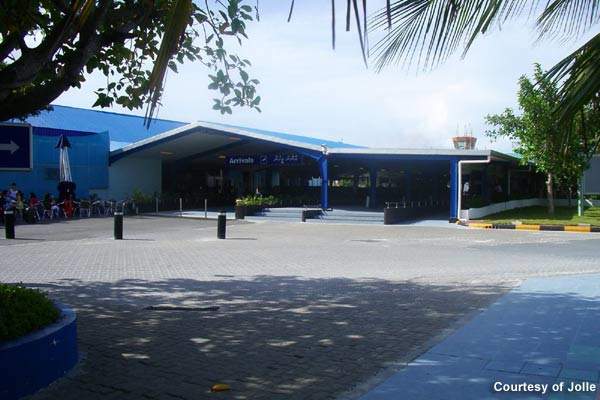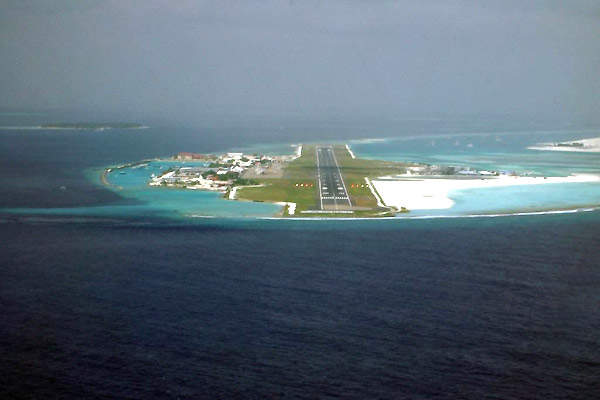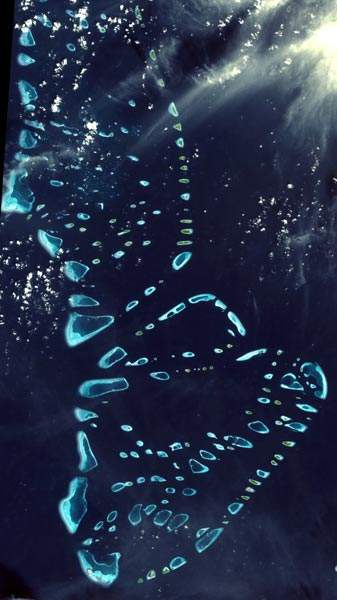Malé International Airport (MLE) (previously known as Hulhule Airport) is the main international airport of the Maldives. It is located 2.5km north-east of Malé, on Hulhule Island. Opened on 12 April 1966, the airport received its new name on 11 November 1981.
The airport handled 300,734 passengers, 6,447,692kg of cargo and managed 4,942 flights in the first quarter of 2009.
The Maldives Airport Company Limited (MACL) managed and operated the airport until November 2010. On 15 July 2010, the airport was privatised after an agreement was signed between Malaysia Airports Holdings Berhad (MAHB) and GMR Male International Airport Private Limited (GMIAL). MACL officially handed over the airport operations to GMIAL on 25 November 2010.
GMIAL had won the bid to modernise and operate the airport on 24 June 2010.
Expansion
The airport modernisation project includes construction of a new 45,000m2 passenger terminal which will be comprised of three independent bridged buildings. Elements within the building will reflect the traditional style of a Maldivian resort.
The capacity of the existing terminals will also be increased as part of the phased expansion. In the first phase the capacity will be increased to 3 million passengers from the existing 2.6 million. In the second phase, it will be increased to five million.
The modernisation is estimated to cost $511m. Construction will start in the first quarter of 2011 and is scheduled to be completed by 2014.
Malé International redevelopment
In November 2008, the Maldivian Government invited expression of interest (EOI) from various international airport operators to set up a mutually benefiting joint venture to develop, manage and operate the airport. In January 2009, the Maldivian Ministry of Finance and Treasury announced that 19 parties had expressed interest for the tender.
In August 2009, the International Finance Corporation (IFC), a member of the World Bank Group, agreed to work with the Maldivian Government to redevelop MLE to offer better passenger services, and enable the tourism-based economy to sustain global slowdown.
Following the advice of the IFC, MACL allowed the entry of private capital to improve the management and profitability of the airport.
The Maldivian Government has been receiving finance to support its airport developmental activities from various funds, agencies and organisations. In November 2005, the Kuwait Fund for Arab Economic Development signed a loan agreement with the Maldivian government to finance the phase IV development of Malé International Airport.
In February 2009, the Board of the Kuwait Fund for Arab Economic Development stated that they had cancelled the loan agreement for the financing the phase IV development activities of the MLE.
Terminal features
MLE operates two terminals – the international terminal and the domestic terminal. The old international terminal was able to accommodate approximately 350 passengers at a time, but increasing passenger number led to the construction of a new two-storey terminal that can accommodate more than 1,000 passengers at once. The ground floor of the terminal houses the departure area, arrivals area and a few restaurants. The first floor features restaurants, shops and waiting lounges.
The arrival terminal has a branch of the Bank of Maldives located by the exit door, offering foreign exchange services. There is also a post office beside the entrance of the departures hall.
Internet stations and laptop connections are available at the Dhiraagu Airport Cyber Cafe. The airport is also Wi-Fi enabled. The Finifenmaa Lounge on the first floor of the terminal is equipped with satellite television, internet access, telephones and a fax machine.
The terminal also holds a few duty-free shops, special souvenir shops, a flower shop and a pharmacy. The departure lounge has a security office with a 24-hour lost-and-found counter.
Other passenger services include a 24-hour healthcare centre to provide first aid and treat minor health emergencies, which is managed and operated by the Ministry of Health. A special care service for expectant mothers and newborn babies is also available. Play areas for children are located in the transit and park areas. Free shower rooms next to the ‘Mariyaad’ coffee shop are available for travellers. A prayer room is located on the first floor of the terminal and a mosque is located nearby.
The domestic terminal opened for public use in December 2006. Construction work began in June 2004 and the terminal was complete by November 2005. The purpose of constructing a separate domestic terminal was to eliminate the space constraints and improve security and safety. This terminal has eight passenger check-in counters. Wheelchair services and jetty services are offered to domestic passengers at the domestic terminal, which can handle up to 140 passengers at a time.
Runways
The first runway was opened in 1960. This 75ft×3,000ft runway is made of slotted steel sheets.
In 1964, a new asphalt runway was constructed; it was opened for public use in 1966. Elevated at 6ft 2in from the average sea level, runway 18/36 is 3,200m (10,499ft) long.
Airport systems
The automatic terminal information service (ATIS) broadcasting system was introduced to Malé International Airport in October 1997. This system broadcasts recorded non-control information to the pilots in busier terminal areas.
Terma delivered an ATIS Plus system to MLE in March 2009. This system provides combined ATIS broadcast in a single or main standby configuration.
Transport infrastructure
There is no road access to the airport. Passengers reach MLE from Malé by water ferries and airline services. A ferry service operates 24 hours and a private airline offers pick-ups and drops to various destinations in the area.
Contractors
Kocks Consult and Air Consult, a consulting group of the Frankfurt Airport Authority were assigned the responsibility of studying future traffic flows and designing the airport in 1976. The $32.4m contract was financed by various banks and agencies.
In September 1978, Standard Elektrik Lorenz (SEL) entered into an agreement with the Maldivian Government to provide telecommunications and navigation systems and related work.
In 1996, a contract to install a fire hydrant system costing $650,000 was signed by the Maldives Airport Authority with Halcham Fire Engineering and Instrumentation.






